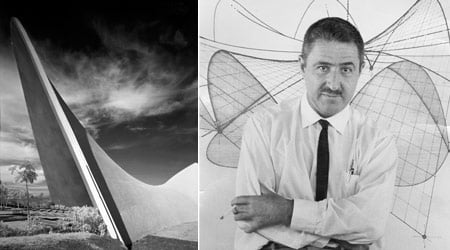'Félix Candela, 1910-2010: A century'

Candela’s work based on hyperbolic paraboloid geometry broke barriers between architecture and engineering, opening a new way of architecture.
Félix Candela is regarded as one the greatest Spanish architects of the 20th century. He is celebrated for his feats of architectural engineering that transform concrete into visual poetry with his structural design based on hyperbolic paraboloid geometric form. His work with thin-shell concrete roof structures broke barriers between architecture and engineering that opened the way for other architects such as Santiago Calatrava.
His works are located in Mexico, the United States, Spain, Venezuela, Colombia, Peru, Guatemala, Puerto Rico, Ecuador, Great Britain and Norway. His commitment to making economic, long-lasting, beautiful works made him the precursor of sustainable architecture.
Born in Madrid, Candela received his architectural training at the Academy of Fine Arts of San Fernando, Spain, where he learnt his reinforced concrete shell techniques under the wing of Eduardo Torroja. Candela exiled to Mexico in 1939 following the Spanish Cilvil War, where co-founded the construction firm Cubiertas Ala. It was there that Candela's career reached its peak.
The success of his work in Mexico led to commissions thoughout Latin America and Europe. In total Cadela made 1,439 projects, of which 896 were built in countries as far flung as Mexico, the United Status, Spain, Venezuela, Colombia, Peru, Guatemala, Puerto Rico, Ecuador, Great Britain and Norway.
The exhibition at the Wallach Art Gallery revolves around Candela's vast body of work including the Cosmic Rays Laboratory, his first hyperbolic paraboloid shell; and his self-identified favorites —Los Manantiales Restaurant, Chapel Lomas de Cuernavaca, Church of Our Lady of the Miraculous Medal all in Mexico, and the Bacardí Rum Factory in Puerto Rico.
The exhibition includes 21 scaled models, a selection of pictures from prestigious photographers, a documentary and a number of videos and animations of his emblematic work. Notable is a selection of original architectural drawings and renderings from the Drawings and Archives Collection at Columbia's Avery Architectural and Fine Arts Library. The exhibition has been organized by Acción Cultural Española.
- Architecture
- New York
- Feb 11, 2012 – Mar 31, 2012
Venue
Wallach Art Gallery, 826 Schermerhorn Hall, 1190 Amsterdam Ave, Columbia University, New York, NY 10027
View on Google Maps